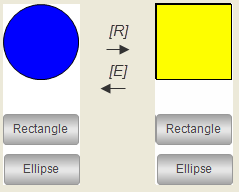Configuring Keyboard Shortcuts
You can define hotkeys and assign specific actions to them. At runtime, a visualization detects the keyboard input event and executes the action.
There are different locations where you can configure a keyboard input event.
The options include the following:
Configure keyboard input for a specific element.
Configure keyboard input for a specific visualization.
Configure keyboard input that is valid for all visualizations.
Select the default hotkeys.
If the visualization integrated in CODESYS is executed, then you can deactivate the keyboard input of the visualization in order to use the hotkey from CODESYS in this state.
Configuring hotkeys for elements
You can define a hotkey that triggers an action for an element. The element has to be visible and operable. For this purpose, the property is available in the Properties view of the visualization editor.
Requirement: A CODESYS project with the existing visEllipse and visRectangle visualizations is open.
Select the application in the device tree and add a visualization named
visMain.The visualization editor opens.
In the Visualization ToolBox view, select and drag the Frame element to the editor.
The Configuration of Frame Visualizations dialog opens.
Double-click in succession the
visEllipseandvisRectanglevisualizations in Available Visualizations.The visualizations appear in Selected Visualizations.
Click OK to exit the dialog.
The visualization contains a new element type Frame. The 2 selected visualizations appear under its property References.
In the editor, the frame shows the visualization with the index
0.Add a button and configure its properties:
In the property, enter
Rectangle.In the property, select Toggle frame visualization on the
visRectanglevisualization.In the property, specify the value
R.The button has a user input and a hotkey.
Add a button and configure its properties:
In the property, enter a
Ellipse.In the property, select Toggle frame visualization on the
visEllipsevisualization.In the property, specify the value
E.The button has a user input and a hotkey.
Click for the device and start the application.
The visualization starts. It has a frame where one of the referenced visualizations runs. Focus on the
visEllipsevisualization and press E. The visualization switches the contents in the frame to thevisEllipsevisualization. When you press R, the visualization switches the contents in the frame to thevisRectanglevisualization.
Configuring hotkeys for a specific visualization
You can define hotkeys that trigger an input action on a specific visualization. The Keyboard Configuration tab in the editor of the visualization is used for this purpose.
Requirement: A CODESYS project with the visEllipse and visRectangle visualizations is open.
Open the CODESYS TargetVisu object and select
visEllipseas the start visualization.Open the
visEllipsevisualization and click the Keyboard Configuration tab.Click .
The Keyboard Configuration tab opens.
Select the value
Cin the Key column.Activate the Press key option.
Select the Change shown visualization value in the Action Type column.
Select
visRectanglein the Action column.The user input is configured for C.
Open the
visRectanglevisualization and click the Keyboard Configuration tab.Select the value
Cin the Key column.Activate the Press key option.
Select the Change shown visualization value in the Action Type column.
Select
visEllipsein the Action column.The user input for C is also configured for this visualization.
Build the application.
Click for the device and start the application.
The visualization starts and displays an ellipse. Focus on the
visEllipsevisualization and press C. ThevisRectanglevisualization is displayed. Focus on the visualization and press C again. Now the visualization is switched again tovisRectangle.
Configuring hotkeys for all visualizations in the application
You can define hotkeys that trigger the same input action for all visualizations of the application. The Default Hotkeys tab in the Visualization Manager is available for this purpose.
Requirement: A project with a visualization is open.
Open the visualization.
Add a rectangle.
Configure its property with
Hotkey.Double-click the GlobalTextList object.
Click in the table, Add Language, and then specify
de.The language
deis configured.Click in the table, Add Language, and then specify
en.The language
enis configured.Configure translations for
deandenfor the textHotkey.Hotkey Keyboard Shortcut HotkeyOpen the Visualization Manager and select the Default Hotkeys tab.
Specify
Din the Key column.Activate the Press key option.
Select the Change language value in the Action Type column.
Select the language
dein the Action column.The keyboard event for D is configured.
Specify
Din the Key column.Activate the Press key option.
Select the Alt option.
Select the Change language value in the Action Type column.
Select the language
enin the Action column.The keyboard event for Alt+D is configured.
Compile, download, and start the application.
The visualization opens.
As the visualization user, press D.
The text is displayed in the language
de.
Activating standard keyboard handling
When you activate the universal hotkeys for standard keyboard handling, the user can operate the visualization without a mouse. Elements that respond to user input can process a keyboard event instead of a mouse event without adapting its input configuration.
Requirement: A project with a visualization is open.
Click the Visualization Manager object.
Activate the Activate standard keyboard handling option.
The universal hotkeys are activated.
Download the application to a device and start the application.
The visualization starts. Now operation can proceed without the mouse. You can navigate in the window by means of the Arrow and Tab keys and press Enter instead of the mouse button.
Activating and deactivating hotkeys for integrated visualizations
When you execute the visualization as an integrated visualization, the command is available in order to deactivate the capturing of keyboard events. It is actually possible for the same keyboard shortcuts to be defined in the visualization and in CODESYS.
When you activate the command, the visualization executes the configured keyboard events.
When you deactivate the command, CODESYS executes the keyboard events. Capturing keyboard events is then deactivated for the visualization.